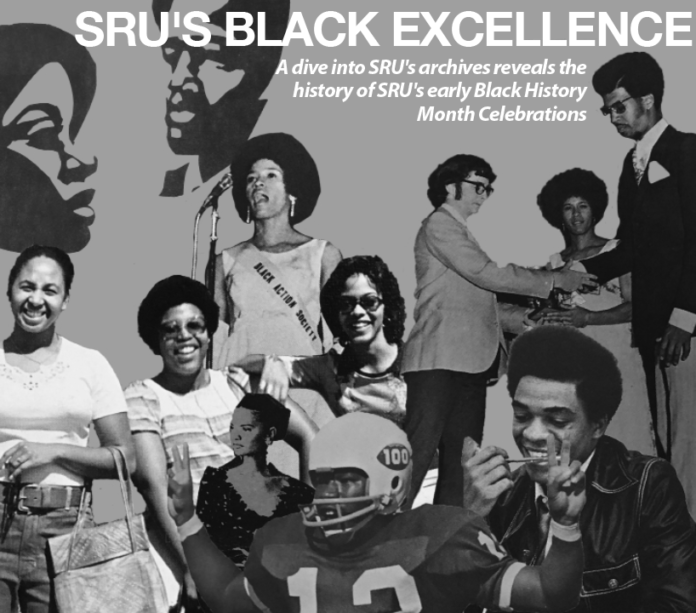Slippery Rock University’s observance of Black History Month has changed tremendously since they first started celebrating African Americans in 1973. The original dedication to black students at SRU was called “Black Is” week and was celebrated for one week in September, until 1976 when SRU began recognizing Black History Month in February.
The following are the major events that have taken place in SRU history from the 1970s through the 1990s.
1973
The first ever “Black Is” week took place to celebrate Black Americans at SRU in February. This week began before the official Black History month was first observed at SRU in 1976.
1974
The first “Soul Food” dinner took place in the Black Cultural Media Information Center on Tuesday, Feb. 12.
Black Action Society, according to their printed program in 1974, “tries to accomplish what all Black organizations are striving for—it tries to help each individual to find his own identity and make him a better person…The Black Action Society is still in its infant stages, as are most SRSC activities involving blacks. However, progress has been realized and we look to the future with great expectations.”
Black athletes participated in track and field, gymnastics, basketball, swimming, football and just about all of the major sports. Black women finally gained recognition for participating in field hockey, basketball, volleyball,and track and field. “In the past, Black athletes at Slippery Rock were praised on the playing field but somewhat ignored on campus,” a booklet given out by the 1974 Black Action Society said. “Currently, the individuality and total capabilities of Black athletes are being recognized and appreciated as the number of Black athletes and Black students continues to grow.”
An article was published that interviewed several Black and White students about interracial dating. Black students replied with answers such as, “I’m not for it. It is up to the individual but I wouldn’t do it,” “Not at this point in history,” and “Even though people are of two different races, it should be accepted if they are into each other.” White students, on the other hand, replied with “I have nothing against it. It may eventually through time, bring about a better, healthier, and closer society,” “There are men, not colors,” “It depends on the two people,” “I think it sucks,” and “If they really like each other, it is not going to matter anyway.”
“Black Is” week took place during the week of Sept. 23-26 and featured events such as poetry, a dance workshop and an art display.
1975
The week of Feb. 10-15, Black History week observed “’Black is’ Week at The Rock.” This week included a variety of activities including a speaker, nationally recognized play, a Charity Ball for Sickle Cell Anemia and comedian Ron Douglas.
The first Black Action Society charity ball took place on Feb. 15.
1981
On March 3, A debate was held between The Black Action Society and the students in Free Enterprise. The debate topic was “The Bakke Decision Will Inhibit The Cultural Growth of Minorities and Retard Affirmative Action Programs in America.”
1988
The Black Action Society hosted their first march to honor Martin Luther King, Jr.’s birthday on Jan. 16. The march was to mark King’s 60th Birthday and began at Weisenfluh and went to Swope Music Hall. The Slippery Rock Gospel Choir sung following the march in honor of MLK.
On Feb. 23, Yolanda King, daughter of Martin Luther King Jr., was a keynote speaker at SRU. Her speech was called “A Dream Deferred.” The event was put on by Black Action Society and there was a reception following the keynote for anyone to attend. King was born in Montgomery, Alabama just two weeks before Rosa Parks refusal to give up her seat on the bus that triggered the movement that ultimately desegregated the south and led to the assassination of her father. King spoke about these events and her life experiences participating in numerous civil and human rights demonstrations.
1989
On Feb. 1, Artist Willis “Bing” Davis was among five artists who presented a show of African American art at the Martha Gault Art Gallery beginning Feb. 14. Davis’ work (at the time) was included in more than 35 solo and 50 group exhibitions. Davis was also president of the National Consortium of Arts and Letters of Historical Black Colleges and Universities; chairperson of the art department at Central State University in Wilberforce, Ohio; and a member of the Ohio Arts Council. In addition to the exhibition, Davis presented a lecture to SRU students on Feb. 28 in Eisenberg Auditorium and did a pottery demonstration in the SRU ceramics studio on March 1.
“Ma Rainey’s Black Bottom” by playwright August Wilson of Pittsburgh was staged at SRU on March 14 in Miller Auditorium. The production was part of the University’s Artist Series. It was a period “blues-drama” that focused on the “brutal impact of racism, oppression and self-hate of the spirit.”
1990
The Black Action Society conducted its first annual “Cultural Enhancement Video Series.” The videos were shown on specific weeks and were intended to better educate the members of the campus community on African Americans. “Many individuals on our campus are not aware enough of the history, accomplishments, and experiences of Black Americans,” Jacquilene Jackson, the coordinator of the video series said.
The Black Action Society sponsored a five-part video series, “Looking Back to Move Forward,” featuring the history and accomplishments of African Americans. Each video installment was an hour long and covered a range of topics from black artists to “life for Namibians under South African rule.” Each showing was followed by discussion with the audience.
Jan. 30 — “Black Artists in the Theatre and Film” featured an interview with Melissa Tillman.
Feb. 13 — “Devil’s Circle” was a documentary filmed secretly by British journalists detailing the grim reality of life for Namibians under South African rule, and “Namibia” was shot on location in Angolan refugee camps.
Feb. 27 — “Music Beautifully Black” was a retrospective of great jazz and blues musicians from the 1920s, and “All Things Considered Black” featured accounts of black experiences in dance, drama and music.
March 20 — “Hairpiece: A Film for Nappy-Headed People” was a humorous animated short that explored black concepts of beauty, and “A Reunion with the Land” told the story of the grandson of a slave and memories of life post-slavery.
April 30 — “Never Turn Back” told of the life of civil rights activist Fannie Lou Hamer.
Winifred R. Owens-Hart, an African American ceramics expert and professor of art at Howard University, visited SRU on Feb. 7-8 to offer lectures and demonstrations, including a discussion of the affect the people of Nigeria had on her talent and her affect on them. The two-day event was sponsored by the SRU Minority Affairs Office, the Black Action Society and the SRU art department. In talking about her visit with artisans of Nigeria, she noted, “The first experience with women in Ipetumodu was exhilarating. When I returned to the U.S., I directed all my energy toward practicing the traditional techniques of African pottery making and raising enough money to return to Ipetumodu.”
1990
SRU’s dance program paid tribute to black choreographer Alvin Ailey Feb. 28 in Miller Auditorium as part of the university’s Black History Month celebration. Ailey, a famed New York choreographer, passed at the age of 58 in December of 1989. “Textures: A Dance Celebration” was performed by 15 dancers, and the performance was sponsored by the Office of Minority Student Affairs and Special Events.
Former SRU President Robert N. Aebersold met with 30 African American students Feb. 12 to discuss a racial incident that had occurred the day before. A series of racial slurs in and about the Keister Apartment complex early Feb. 11 led to a physical altercation. That same evening, residents in the apartment complex saw a cross being burned in front of an African American’s apartment. During the meeting, Aebersold said, “The university is committed to ending racial divisiveness. We have a diverse student body by design and want to expose our students to a variety of cultures so that they can learn to work, develop and grow together.” Three days after the incident occurred, two SRU students were arrested in connection with the incident.
1991
A gender and race integration project, intended to support faculty’s effort to revise their courses to include the achievements of women and African Americans, was taken over by Professor Jace Condravy.
1991
The Black Action Society hosted its first ever Duke and Duchess Pageant in Miller Auditorium.








